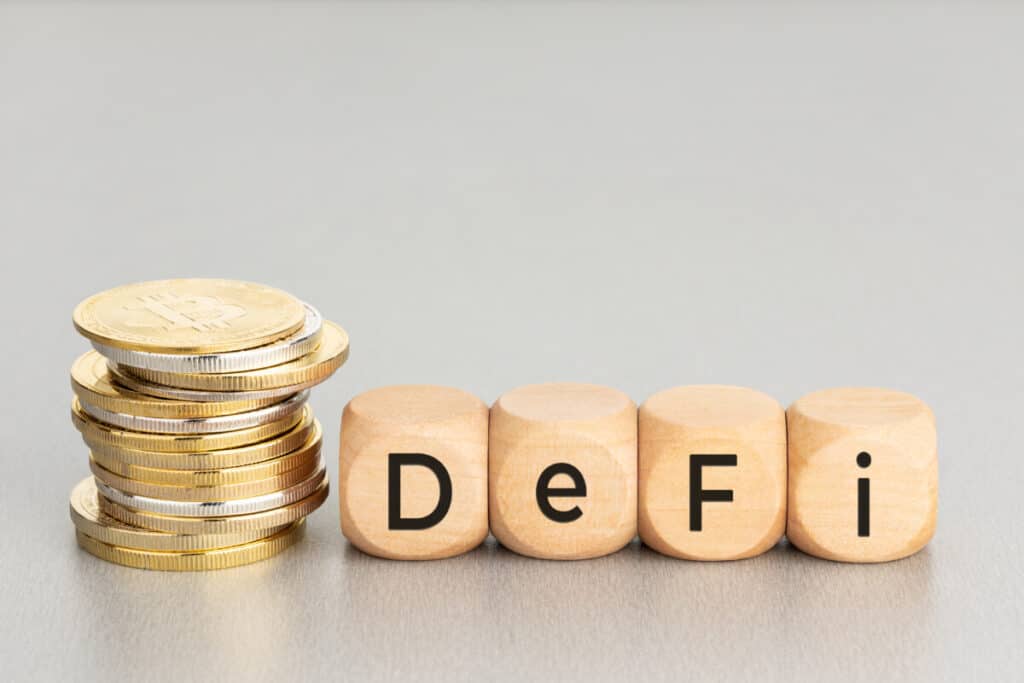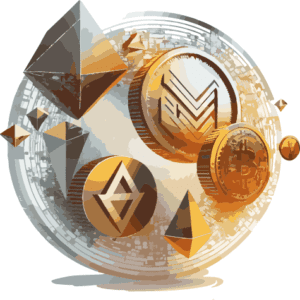The Defi, the buzzword we hear almost daily, is meant to change our financial destiny, but what Decentrilezed Finance actually is?

Decentralized Finance (DeFi) is a digital financial system built on blockchain technology that enables the creation and use of financial instruments and services without intermediaries such as banks. It allows for peer-to-peer transactions, increased transparency and security, and the democratization of financial services.
Understanding DeFi
Definition and explanation of key terms
When trying to wrap one’s head around Decentralized Finance (DeFi), it helps to have a firm grip on the core concepts that form the backbone of this game-changing technology.
For instance, a blockchain is a digital ledger that keeps track of all transactions within a network. Blockchain technology is appropriate for use in the financial sector because it is decentralized (not controlled by a central authority) and safe.
Contrarily, “smart contracts” are computerized contracts whose conditions can be carried out mechanically per their terms.
Defi is supported by the combination of blockchain technology and smart contracts, which ensure the safety and transparency of financial transactions while eliminating the need for middlemen.
Comparison of DeFi to traditional finance
There are many ways in which DeFi departs significantly from the conventional financial system. When one thinks of “conventional finance,” one often sees a bank at the centre of all financial dealings and services.
Because of this concentration of power, there is less openness and fewer opportunities for people to use their own agency. However, there is no central authority over DeFi because it is designed on a decentralized network.
As a result of this decentralization, information is more easily shared and accessible, and people have more say over their own lives. Also, compared to conventional financial transactions, DeFi ones tend to be swifter and less expensive.
Advantages of DeFi (e.g. transparency, security, accessibility)
Many of us prefer DeFi to more conventional forms of finance because of its many benefits.
Due to its distributed nature, DeFi guarantees that all transactions are publicly documented and accessible.
Because of the cryptographic protection afforded to each transaction in a blockchain, we can use smart contracts with complete confidence.
And lastly, unlike conventional financing, DeFi is open to anyone with an internet connection, regardless of location or means.
DeFi Applications
Overview of popular DeFi platforms and applications
DeFi can be used for many purposes, including but not limited to lending, borrowing, trading, and more. The following are just a few examples of widely used DeFi systems:
There are several online lending marketplaces, like Aave, Compound, and MakerDAO, where users may lend and borrow a wide range of cryptocurrencies and digital assets at interest rates that fluctuate with supply and demand.
They decentralized trading systems where users may buy and sell cryptocurrencies and other digital assets without using a centralized exchange. Examples include Uniswap, Sushiswap, and 0x.
Nexus Mutual is an example of a decentralized insurance platform where users can insure their digital possessions.
These systems are only a tiny sampling of the many existing DeFi software options. There are perks and advantages to each platform, and they’re all improving all the time.
Case studies of specific DeFi projects and their impact
MakerDAO is an excellent example of a successful DeFi project since it enables borrowers to secure loans with Ether and a stablecoin (DAI) (ETH).
The success of MakerDAO’s decentralized lending platform in offering a stablecoin untethered from any fiat currency is a prime example of how DeFi can deliver previously unavailable financial products.
Another example is Uniswap, a decentralized exchange that eliminates the need for a centralized marketplace for buying and selling digital assets like cryptocurrency.
With daily trade volumes often exceeding those of centralized exchanges, Uniswap has quickly risen to prominence as one of the most prominent DeFi platforms.
Discussion of potential future developments and use cases for DeFi
DeFi’s potential is practically boundless because it has so many possible applications. However, here are a few things that could happen in the near future:
Individuals and small enterprises worldwide may benefit from decentralized finance since it creates a level playing field for them to access financial services.
Quote from Vitalik Buterin, one of Ethereum’s original creators.
“The combination of DeFi and ‘legacy’ finance, which opens the door for the use of digital assets in ‘legacy’ financial transactions and benefits consumers and businesses alike”.
The application of DeFi for a good cause, like helping the unbanked or sponsoring eco-friendly initiatives.
DeFi is in its infancy, but it has enormous prospects for development and improvement. More use cases and innovations that alter our perspectives on and interactions with a currency will likely emerge as the technology and ecosystem mature.
Risks and Challenges
Discussion of potential risks associated with DeFi (e.g. regulatory challenges, security threats)
As with any developing technology, DeFi presents a variety of risks. Let’s take a look at some of the most significant threats:
Problems with Regulation Regulators are struggling to keep up with the dynamic nature of the DeFi ecosystem. Despite some governments’ hands-off approach to DeFi, others have adopted rules that can make it difficult for DeFi projects to launch.
Although DeFi is less vulnerable to hacking and other security vulnerabilities because of the lack of a centralized server, these concerns remain.
In addition, some members of the DeFi community are worried that smart contracts may not be as safe as they seem due to phishing and other fraudulent activities.
Liquidity risk occurs when there are not enough ready buyers or sellers of an asset, which has been a problem for some DeFi endeavours.
Because of this, the user may be less able to judge when it is best to sell or make a deal, which can lead to significant financial loss.
Explanation of how DeFi projects are addressing these risks
Several initiatives within the DeFi community are working to mitigate these dangers and strengthen the ecosystem. Here are a few cases in point:
Smart contract audits are being implemented by many DeFi projects to guarantee the safety and robustness of their smart contracts. One option is having third-party auditors examine the code and point out any problems.
Some DeFi initiatives are supplying users with educational materials to help them become familiar with the dangers of DeFi and the steps they may take to safeguard themselves.
It may contain guidance on recognizing and avoiding phishing and other forms of online fraud.
A growing number of decentralized insurance platforms, including Nexus Mutual, offer protection for digital assets and smart contracts, lowering consumers’ exposure to risk.
Analysis of the current state and future of DeFi in terms of its maturity and scalability
Even though DeFi is just getting started, it has already significantly influenced the banking sector. Total DeFi value will hit $13 billion by 2020 and is expected to continue rising.
However, DeFi must first overcome several remaining obstacles to realize its full potential. For example, certain DeFi initiatives still have issues with scalability, making it hard for them to process high transaction volumes.
There are other initiatives where the user experience is murky and hard to grasp.
Despite these difficulties, DeFi’s future seems promising. We may anticipate more developed and user-friendly projects that will make DeFi more accessible to the general public as the ecosystem develops further.
In the words of one expert, “DeFi is the future of finance, and it’s only getting started.” Co-creator of Earn.com: Balaji Srinivasan.
Summary
DeFi is definitely not simply a fad; it’s a new financial ecosystem accessible to everyone and built on the principles of openness, transparency, and decentralization. There is no turning back from this trend; it will shape the future financial sector.
We hope you have enjoyed reading this blog post and have gained valuable insights into the world of DeFi.
If you are interested in learning more about DeFi and crypto-related content, please check out the rest of our website, where you will find more in-depth information on various topics related to DeFi. Thank you for reading!
Recent Posts
A season you awaited probably more than Christmas if you are a true crypto holder is Altcoin Season. What is Altcoin Season? The term "altcoin season" refers to a time when alternative...
Another stablecoin that has been around for some time and gained trust is Binance's BUSD. What is BUSD? Binance USD (BUSD) is a stablecoin pegged to the US dollar and issued by Binance...
